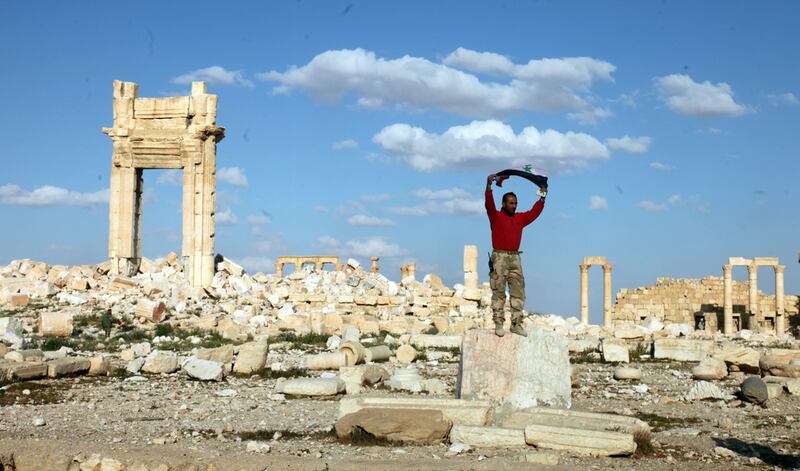The capture of Palmyra this week was a clear attempt by the regime of Bashar Al Assad to rewrite history.
Damascus and its allies presented the victory as part of the wider campaign to strike extremists in Syria.
In truth, they wanted a victory to strengthen the regime’s political position in the peace talks, after a relentless Russian air campaign helped Mr Al Assad’s forces secure its territory and reorganise its forces to launch offensives against mainstream rebel groups.
The recapture of Palmyra does not mean the regime will now focus on ISIL and Al Qaeda-affiliated Jabhat Al Nusra.
Yet Mr Al Assad has successfully turned the narrative upside down in an attempt to showcase his forces as a bulwark against radicalism.
This cynical plan began shortly after Russia launched its military intervention in September. Some observers visiting Beirut, Damascus, Tehran or Moscow returned with a similar conclusion: that a push to retake Palmyra from ISIL was imminent.
As talk of a Palmyra offensive circulated, western governments estimated that more than 90 per cent of Russian air strikes had hit regular opposition forces, not ISIL.
The floating of a plan for a symbolic victory over ISIL was designed to divert attention from the real objective – weakening the opposition and securing the regime’s heartlands.
The expulsion of ISIL from Palmyra should be welcomed by everyone, including the opposition. But a line should also be drawn between celebrating the survival of the ancient ruins and celebrating a dictator that remorselessly reduced much of his country to rubble. For Syrians, Palmyra is symbolic not only for historical reasons but also because its notorious Tadmur Prison epitomised the regime’s repressive machine.
But it is also for practical reasons that the regime’s claims should be rejected.
Some reports stated that the regime would use Palmyra as a launch pad to retake Deir Ezzor and Raqqa from ISIL, despite the fact Raqqa is located much closer to the regime’s strongholds in Aleppo and Hama than Palmyra. Others inaccurately characterised the regime’s win in Palmyra as the biggest military defeat for ISIL in two years.
Observers should not make the mistake of overstating the regime’s capabilities as they did in February when many thought government forces were about to retake Aleppo.
The capture of Palmyra was primarily a political move. Palmyra and Raqqa have suddenly become strategically important for the regime – part of “useful Syria” – to beef up its position as the most effective force against extremists.
The regime may seek to retake the Tabqa airbase in Raqqa to both assert its “sovereignty” on the only province where the regime has no presence and to demonstrate it is a capable force against extremists, especially as the truce between the government and the rebels persists.
But the mainstream rebels will continue to be its main target, a strategy that has long enabled the rise of extremist forces in Syria.
In December 2014, the British defence think tank IHS Jane’s issued data showing that the regime and ISIL were “ignoring each other”. For Syrians inside the country, such strategy was so evident that many went further to claim the regime and ISIL were working together, especially when the two attacked the rebels at the same time or when the regime targeted the rebels and turned a blind eye to the ISIL bases across the country.
The presence of extremist forces is convenient for the Assad regime as long as the rebels pose a threat to its rule. That it will now turn its attention to destroy ISIL is a fantasy, even if it has the strength and resources to do so.
The capture of Palmyra was a clear prize, given its symbolism for people inside and outside Syria.
Yet the response to the capture of Palmyra revealed the vulnerability of outsiders to the regime’s playing of the extremism card.
By rescuing the “pearl of the desert” from ISIL, the regime and its allies wanted to show they are the defenders of civilisation.
But the regime stands accused of being responsible for the rise of these extremist forces, both directly and indirectly, and failing to defend Palmyra as it did other militarily important areas.
foreign.desk@thenational.ae





